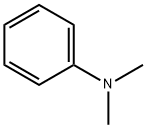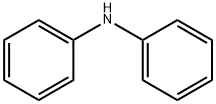N-Propylaniline
- CAS NO.:622-80-0
- Empirical Formula: C9H13N
- Molecular Weight: 135.21
- MDL number: MFCD00048678
- EINECS: 210-754-4
- SAFETY DATA SHEET (SDS)
- Update Date: 2024-12-18 14:15:30

What is N-Propylaniline?
Preparation
N-propylaniline was efficiently synthesized in a vapor phase from aniline and 1-propanol at atmospheric pressure over the Cu/SiO2 catalyst that was prepared by the incipient wetness method and temperature-programmed calcination. The catalyst exhibited very high activity and selectivity. At the reaction temperature of 260°C, 1-propanol conversion reached 100%, and the selectivity for N-propylaniline exceeded 92%. The results of X-ray diffraction showed that the Cu/SiO2 catalyst with high catalytic activity and selectivity had good crystallinity of copper.
https://doi.org/10.1016/S1872-2067(07)60027-8
Properties of N-Propylaniline
| Melting point: | -6.87°C (estimate) |
| Boiling point: | 220°C |
| Density | 0,95 g/cm3 |
| refractive index | 1.5410 to 1.5440 |
| Flash point: | 91°C |
| form | clear liquid |
| pka | 5.04±0.20(Predicted) |
| Specific Gravity | 0.942~0.949 (20/4℃) |
| color | White to Yellow to Green |
| CAS DataBase Reference | 622-80-0(CAS DataBase Reference) |
| NIST Chemistry Reference | N-Propylaniline(622-80-0) |
| EPA Substance Registry System | Benzenamine, N-propyl- (622-80-0) |
Safety information for N-Propylaniline
| Signal word | Danger |
| Pictogram(s) |
 Exclamation Mark Irritant GHS07  Health Hazard GHS08 |
| GHS Hazard Statements |
H227:Flammable liquids H315:Skin corrosion/irritation H319:Serious eye damage/eye irritation H370:Specific target organ toxicity, single exposure H372:Specific target organ toxicity, repeated exposure |
| Precautionary Statement Codes |
P210:Keep away from heat/sparks/open flames/hot surfaces. — No smoking. P260:Do not breathe dust/fume/gas/mist/vapours/spray. P264:Wash hands thoroughly after handling. P264:Wash skin thouroughly after handling. P270:Do not eat, drink or smoke when using this product. P271:Use only outdoors or in a well-ventilated area. P280:Wear protective gloves/protective clothing/eye protection/face protection. P305+P351+P338:IF IN EYES: Rinse cautiously with water for several minutes. Remove contact lenses, if present and easy to do. Continuerinsing. P332+P313:IF SKIN irritation occurs: Get medical advice/attention. P337+P313:IF eye irritation persists: Get medical advice/attention. P370+P378:In case of fire: Use … for extinction. P405:Store locked up. P403+P235:Store in a well-ventilated place. Keep cool. |
Computed Descriptors for N-Propylaniline
New Products
(S)-3-Aminobutanenitrile hydrochloride 4-Methylphenylacetic acid N-Boc-D-alaninol N-BOC-D/L-ALANINOL Tert-butyl bis(2-chloroethyl)carbamate 3-Morpholino-1-(4-nitrophenyl)-5,6-dihydropyridin- 2(1H)-one Furan-2,5-Dicarboxylic Acid Tropic acid 1-Bromo-3,5-Di-Tert-Butylbenzene S-2-CHLORO PROPIONIC ACID ETHYL ISOCYANOACETATE 2-Bromo-1,3-Bis(Dimethylamino)Trimethinium Hexafluorophosphate 4-IODO BENZOIC ACID 3-NITRO-2-METHYL ANILINE 1-(2,4-DICHLOROPHENYL) ETHANAMINE (2-Hydroxyphenyl)acetonitrile 4-Bromopyrazole 2-(Cyanocyclohexyl)acetic acid 4-methoxy-3,5-dinitropyridine 1-(4-(aminomethyl)benzyl)urea hydrochloride 2-aminopropyl benzoate hydrochloride diethyl 2-(2-((tertbutoxycarbonyl)amino) ethyl)malonate tert-butyl 4- (ureidomethyl)benzylcarbamate Ethyl-2-chloro((4-methoxyphenyl)hydrazono)acetateRelated products of tetrahydrofuran








You may like
-
 N-Propylaniline CAS 622-80-0View Details
N-Propylaniline CAS 622-80-0View Details
622-80-0 -
 N-Propylaniline 95% CAS 622-80-0View Details
N-Propylaniline 95% CAS 622-80-0View Details
622-80-0 -
 1975-50-4 98%View Details
1975-50-4 98%View Details
1975-50-4 -
 2-HYDROXY BENZYL ALCOHOL 98%View Details
2-HYDROXY BENZYL ALCOHOL 98%View Details
90-01-7 -
 2-Chloro-1,3-Bis(Dimethylamino)Trimethinium Hexafluorophosphate 221615-75-4 98%View Details
2-Chloro-1,3-Bis(Dimethylamino)Trimethinium Hexafluorophosphate 221615-75-4 98%View Details
221615-75-4 -
 61397-56-6 CIS BROMO BENZOATE 98%View Details
61397-56-6 CIS BROMO BENZOATE 98%View Details
61397-56-6 -
 14714-50-2 (2-Hydroxyphenyl)acetonitrile 98+View Details
14714-50-2 (2-Hydroxyphenyl)acetonitrile 98+View Details
14714-50-2 -
 118753-70-1 98+View Details
118753-70-1 98+View Details
118753-70-1
Statement: All products displayed on this website are only used for non medical purposes such as industrial applications or scientific research, and cannot be used for clinical diagnosis or treatment of humans or animals. They are not medicinal or edible.